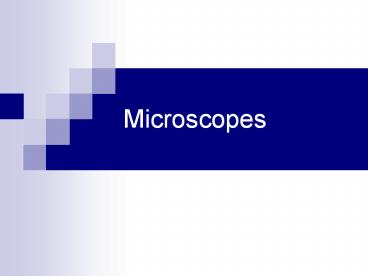Microscopes - PowerPoint PPT Presentation
Title:
Microscopes
Description:
Lenses had been used to magnify images during the first ... A paramecium. http://www.microscope-microscope.org/gallery/Mark-Simmons/pages/paramecium2 .htm ... – PowerPoint PPT presentation
Number of Views:347
Avg rating:3.0/5.0
Title: Microscopes
1
Microscopes
2
Contents
- History
- Structure
- Uses
- Images
3
History
- Invented during the Renaissance
- Lenses had been used to magnify images during the
first century A.D., but it was not until the late
1500 hundreds when two Dutch spectacle makers
started experimenting with several lenses in a
long tube.
4
The Father of Microscopy
- Anton van Leeuwenhoek (1632 1723)
- he taught himself new methods for grinding and
polishing tiny lenses of large curvature - these magnifications of up to 270 diameters
- he was the first to see and describe bacteria,
yeast plants and the circulation of blood
corpuscles in capillaries.
5
Why do we need microscopes?
- Not everything we want to see is visible to the
naked eye. - Microscopes uses lenses to brighten and enlarge
nearby and very small objects.
6
Structure
- Microscopes are almost identical to Keplerian
telescopes, except for their objective lenses. - Microscopes uses a short focal length objective
lens to project a large real image of a nearby
object - They must gather large amounts of light from a
small object using an Objective Lens
7
The Objective Lens
- The microscope objective lens must be very small
and spherical, with a short focal length. - It must be able to
- move in close to the object
- catch its rapidly diverging light rays
- make those rays converge together as a real image
far from the lens - the number marked on the side of the objective
lens will tell you how much the image is
magnified (for example x40)
8
The Objective Lens
- The Objective lens is usually a compound lens, or
a combination of two lenses made from different
types of glass. - The second lens is really there to correct any
distortions caused by the first lens, such as
chromatic abberation.
9
http//www.yesmag.bc.ca/how_work/microscope.html
10
The Eyepiece
- The eyepiece is the second lens in a microscope.
- It is used to magnify the object so it easy to
view with your eyes.
http//www.physics.carleton.ca/watson/1000_level/
Waves_and_Optics/Gifs/microscope_0.gif
11
Illumination
- Illumination is very important in a microscope.
- You can shine a light upward THROUGH the object
which lets you see how much light is absorbed in
different places. - You can shine a light downward ONTO the object
which lets you see how light reflects from the
surface.
12
There are four adjustments to be made when using
a microscope.
- Brightness adjusts how light or dark the image
is using the illumination. - Focus adjusts if the image is blurry or well
defined by using the focus knobs, which change
the location of the focal point. - Resolution defines how easily you can define
two adjacent objects from each other and is
adjusted by the aperture of the objective lens - Contrast which is the difference in lighting
between two areas. This can be adjusted by
changing the intensity of the light and the
pinhole aperature.
13
Uses
- Microscopes have been and are being used in many
different areas, such as - identifying minerals
- solving crimes
- see how freezing affects food
- study human cells
- find the cause of diseases
- discovering where illegal drugs are grown
14
A hydra getting ready for reproduction http//www.
microscope-microscope.org/microscope-images.htm
15
A paramecium http//www.microscope-microscope.org/
gallery/Mark-Simmons/pages/paramecium2.htm
16
A green protist http//www.microscope-microscope.o
rg/gallery/Mark-Simmons/pages/the_fish.htm































